Building an Elastic Parallel OGC Web Processing Service on a Cloud-Based Cluster: A Case Study of Remote Sensing Data Processing Service
Abstract
:1. Introduction
2. Background and Related Work
2.1. Geospatial Processing Service
2.2. Parallel Computing
2.3. Cloud Computing
3. Methodologies
3.1. Logical Architecture
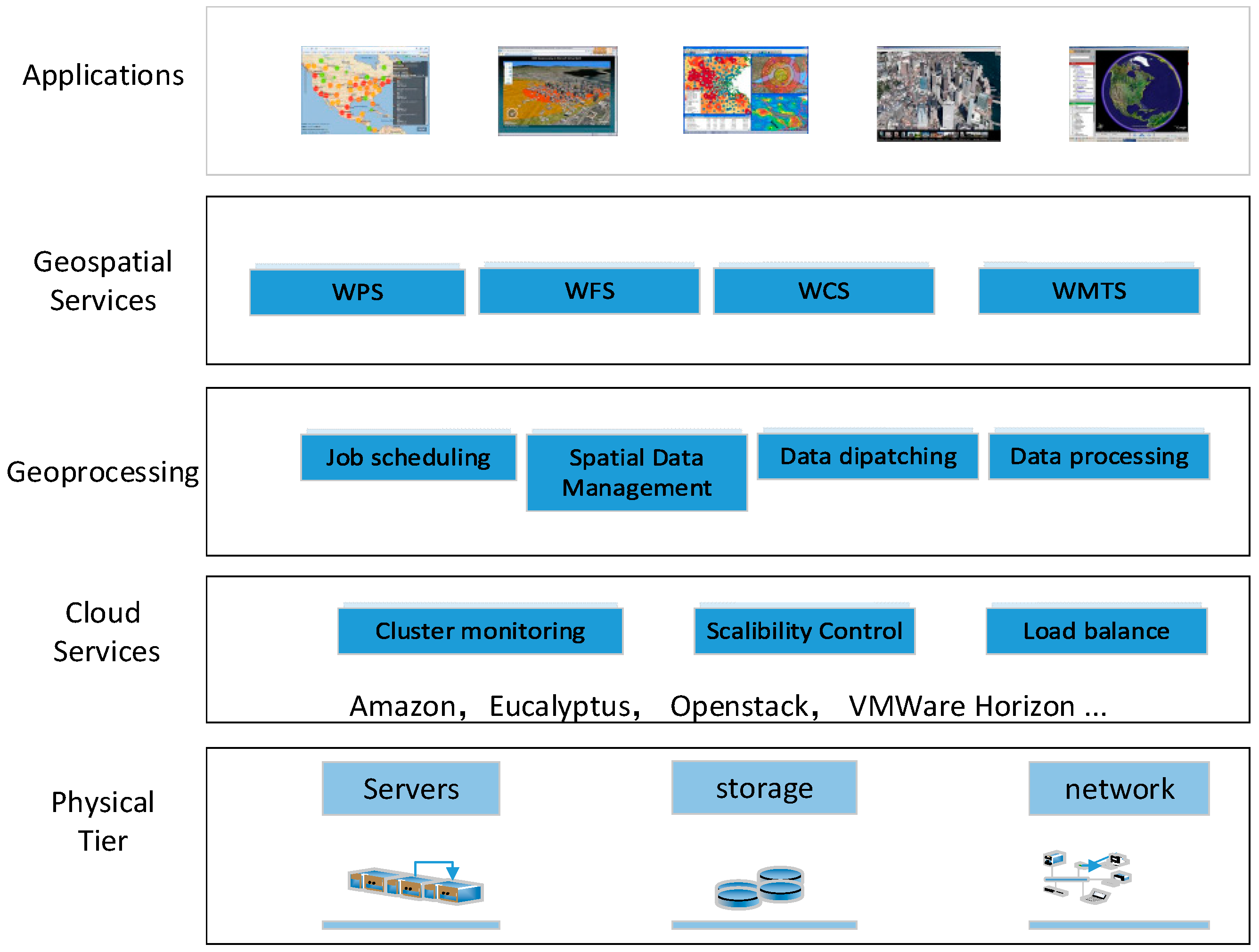
3.2. Scalability Scheme for Parallel Geoprocessing
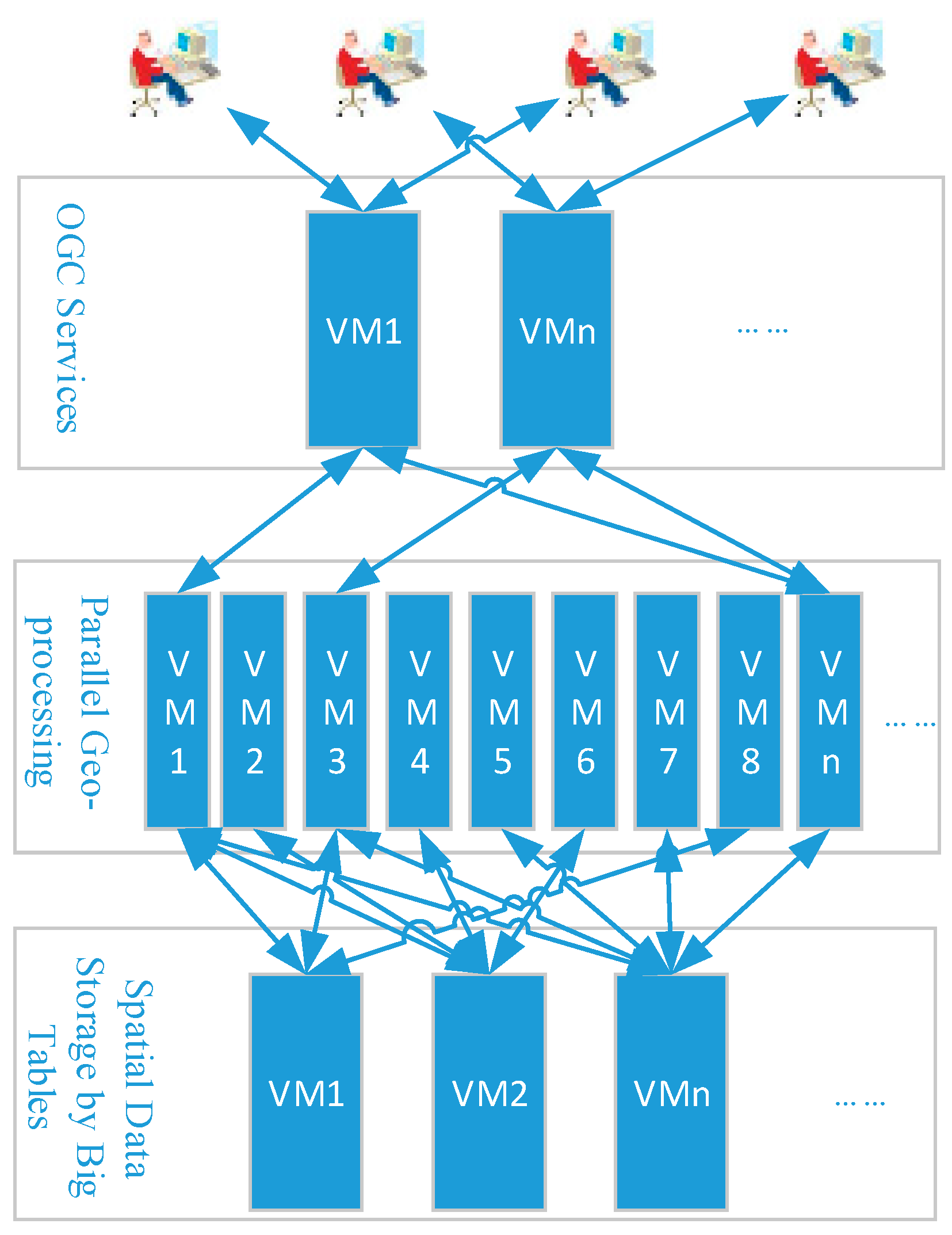
- (1)
- Cluster extension condition:There are jobs that are delayed to execute for more than 3 min.
- (2)
- Cluster shrinkage condition:No Jobs are delayed to execute for less than 2 min.
- (3)
- Cluster stable condition:The jobs must be delayed to execute for more than 2 min and less than 3 min.
3.3. Algorithm of the Elastic Parallel WPS Service
- Step 1:
- The cloud and OGC WPS environment is initiated;
- Step 2:
- OGC WPS receives a request from a client;
- Step 3:
- OGC WPS acquires the parameters from the request and validates them. If problems with the parameters exist, the WPS will return an error message;
- Step 4:
- Based on the parameters that are received, the master will determine the extent of the task and then execute the task decomposition;
- Step 5:
- The job will be submitted to the cloud-based cluster via the PBS;
- Step 6:
- Each worker receives the sub-tasks, retrieves the raster data in its extents from the data tier VMs, and calculates the tiles within its extents. In this step, the data will be transferred to the workers concurrently by the multi-thread method. Except for the first round, waiting for the required data is unnecessary;
- Step 7:
- The master gathers all the result data from all the workers and places the data into a queue. The master then writes the result data values into the raster file. For better performance, the non-blocking communication method is used such that workers can continuously perform computations;
- Step 8:
- If all rounds are completed, the algorithm will go to step 9; otherwise, the algorithm returns to step 5;
- Step 9:
- After all the rounds are completed, all the VMs de-allocate the used memory.
- Step a:
- The cloud-watching node collects the status information of the submitted jobs via PBS commands;
- Step b:
- The status data are evaluated. If the status reaches the threshold, the algorithm goes to step c; otherwise, it returns to step a;
- Step c:
- The cloud-watching node will launch new VMs or terminate existing VMs according to the scalability scheme rules in Section 3.2; then, the algorithm returns to step a.
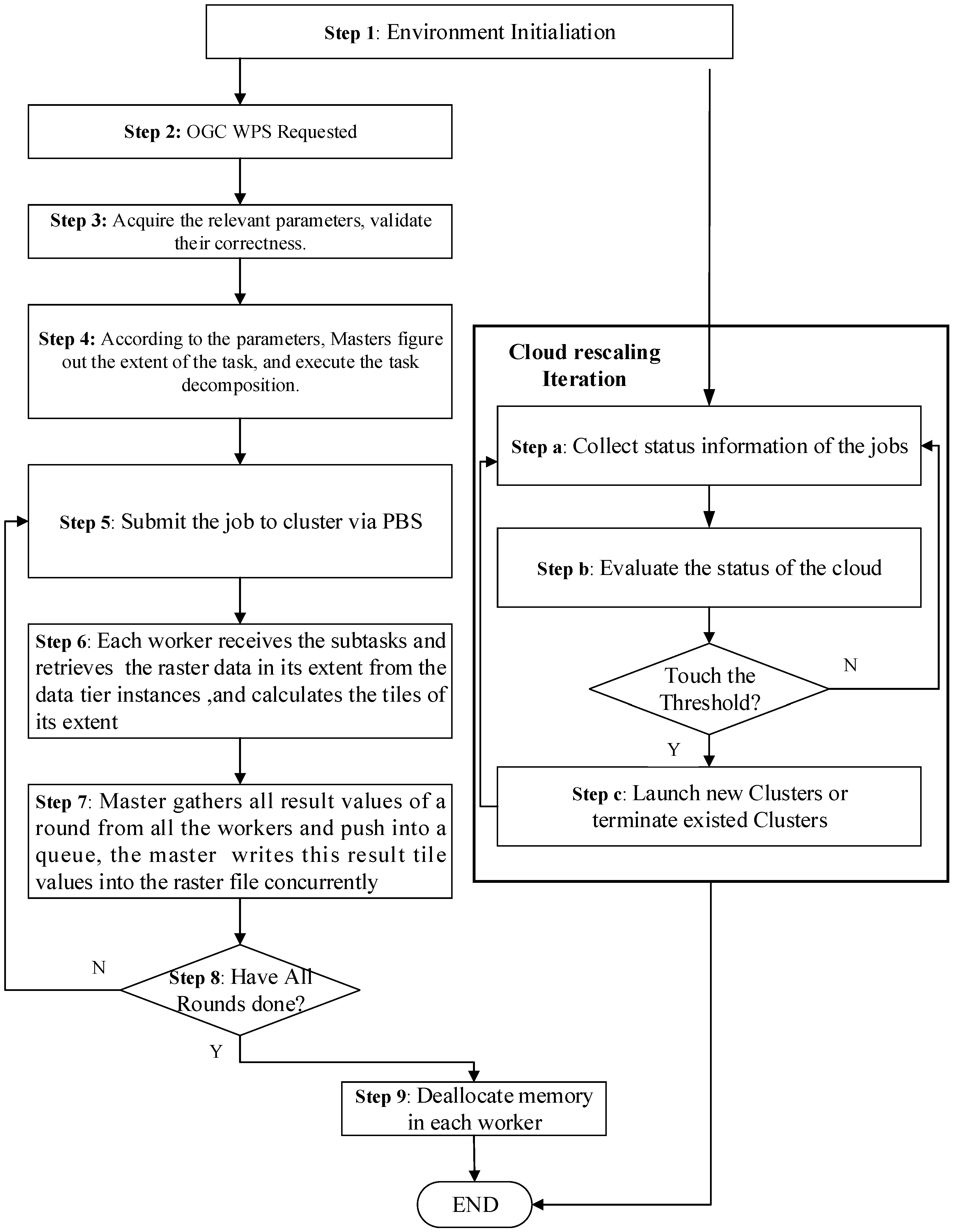
4. Prototype Implementation and Analysis of the Results
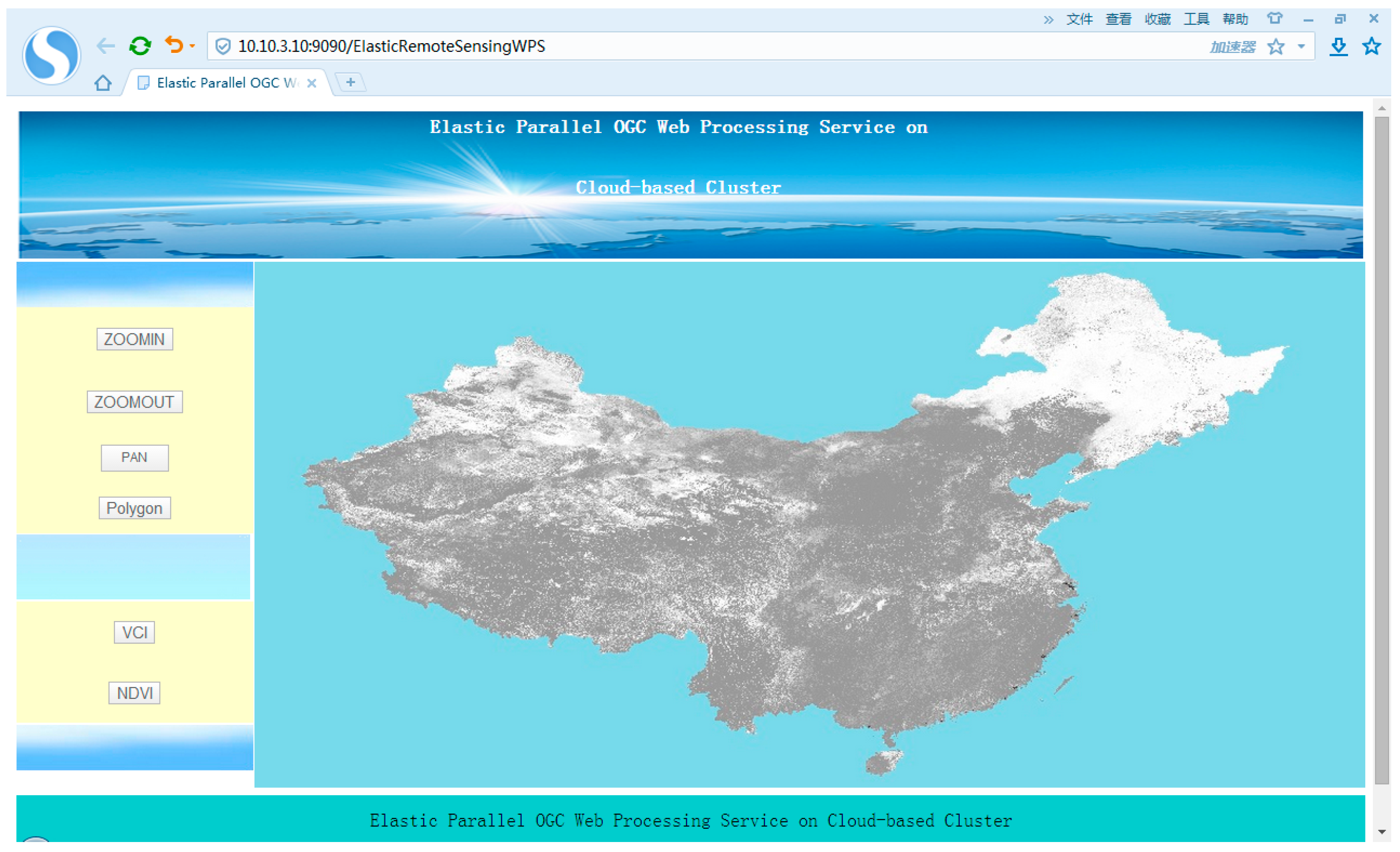

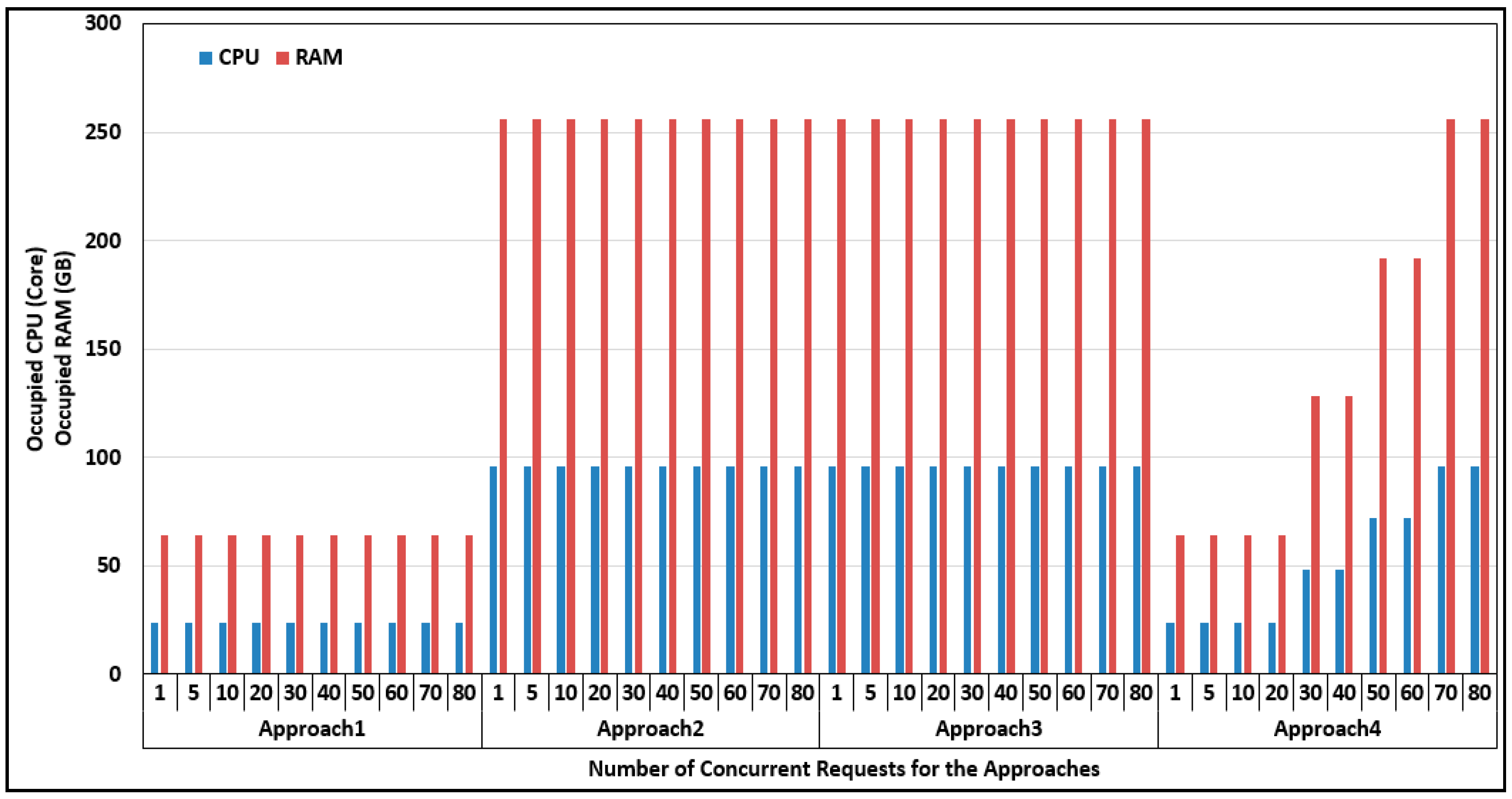
5. Conclusions
Acknowledgments
Author Contributions
Conflicts of Interest
References
- Deng, M.; di, L. GeoBrain Online Resources for Supporting College-Level Data-Intensive Geospatial Science and Engineering Education. In Proceedings of the IEEE International Geoscience and Remote Sensing Symposium (IGARSS), Boston, MA, USA, 7–11 July 2008; pp. IV-443–IV-446.
- Friis-Christensen, A.; Lucchi, R.; Lutz, M.; Ostländer, N. Service chaining architectures for applications implementing distributed geographic information processing. Int. J. Geogr. Inf. Sci. 2009, 23, 561–580. [Google Scholar] [CrossRef]
- Di, L.; Zhao, P.; Yang, W.; Yue, P. Ontology-driven automatic geospatial-processing modeling based on web-service chaining. In Proceedings of the Sixth Annual NASA Earth Science Technology Conference, College Park, MD, USA, 27–29 June 2006; pp. 27–29.
- Yue, P.; di, L.; Yang, W.; Yu, G.; Zhao, P. Semantics-based automatic composition of geospatial web service chains. Comput. Geosci. 2007, 33, 649–665. [Google Scholar] [CrossRef]
- Yue, P.; Gong, J.; Di, L. Augmenting geospatial data provenance through metadata tracking in geospatial service chaining. Comput. Geosci. 2010, 36, 270–281. [Google Scholar] [CrossRef]
- Sorokine, A. Implementation of a parallel high-performance visualization technique in GRASS GIS. Comput. Geosci. 2007, 33, 685–695. [Google Scholar] [CrossRef]
- Huang, Q.; Yang, C.; Benedict, K.; Rezgui, A.; Xie, J.; Xia, J.; Chen, S. Using adaptively coupled models and high-performance computing for enabling the computability of dust storm forecasting. Int. J. Geogr. Inf. Sci. 2013, 27, 765–784. [Google Scholar] [CrossRef]
- Armbrust, M.; Fox, A.; Griffith, R.; Joseph, A.D.; Katz, R.; Konwinski, A.; Lee, G.; Patterson, D.; Rabkin, A.; Stoica, I.; et al. A view of cloud computing. Commun. ACM 2010, 53, 50–58. [Google Scholar] [CrossRef]
- Briggs, D.J.; Collins, S.; Elliott, P.; Fischer, P.; Kingham, S.; Lebret, E.; Pryl, K.; van reeuwijk, H.; Smallbone, K.; van der veen, A. Mapping urban air pollution using GIS: A regression-based approach. Int. J. Geogr. Inf. Sci. 1997, 11, 699–718. [Google Scholar] [CrossRef]
- Chuvieco, E. Integration of linear programming and GIS for land-use modelling. Int. J. Geogr. Inf. Sci. 1993, 7, 71–83. [Google Scholar] [CrossRef]
- Bojórquez-Tapia, L.A.; Diaz-Mondragón, S.; Ezcurra, E. GIS-based approach for participatory decision making and land suitability assessment. Int. J. Geogr. Inf. Sci. 2001, 15, 129–151. [Google Scholar] [CrossRef]
- Mathiyalagan, V.; Grunwald, S.; Reddy, K.R.; Bloom, S.A. A WebGIS and geodatabase for Florida’s wetlands. Comput. Electron. Agric. 2005, 47, 69–75. [Google Scholar]
- Kraak, M. The role of the map in a Web-GIS environment. J. Geogr. Syst. 2004, 6, 83–93. [Google Scholar] [CrossRef]
- Jia, Y.; Zhao, H.; Niu, C.; Jiang, Y.; Gan, H.; Xing, Z.; Zhao, X.; Zhao, Z. A WebGIS-based system for rainfall-runoff prediction and real-time water resources assessment for Beijing. Comput. Geosci. 2009, 35, 1517–1528. [Google Scholar]
- Castronova, A.M.; Goodall, J.L.; Elag, M.M. Models as web services using the Open Geospatial Consortium (OGC) Web Processing Service (WPS) standard. Environ. Model. Softw. 2013, 41, 72–83. [Google Scholar] [CrossRef]
- Chen, Z.; Chen, N.; Yang, C.; Di, L. Cloud computing enabled Web processing service for Earth observation data processing. IEEE J. Sel. Top. Appl. Earth Obs. Remote Sens. 2012, 5, 1637–1649. [Google Scholar] [CrossRef]
- Di, L.; Chen, A.; Yang, W.; Liu, Y.; Wei, Y.; Mehrotra, P.; Hu, C.; Williams, D. The development of a geospatial data Grid by integrating OGC web services with globus-based Grid technology. Concurr. Comput. Pract. Exp. 2008, 20, 1617–1635. [Google Scholar] [CrossRef]
- Zhang, T.; Tsou, M. Developing a grid-enabled spatial web portal for internet GIServices and geospatial cyberinfrastructure. Int. J. Geogr. Inf. Sci. 2009, 23, 605–630. [Google Scholar] [CrossRef]
- Han, W.; Yang, Z.; Di, L.; Mueller, R. CropScape: A web service based application for exploring and disseminating US conterminous geospatial cropland data products for decision support. Comput. Electron. Agric. 2012, 84, 111–123. [Google Scholar] [CrossRef]
- Granell, C.; Díaz, L.; Gould, M. Service-oriented applications for environmental models: Reusable geospatial services. Environ. Model. Softw. 2010, 25, 182–198. [Google Scholar] [CrossRef]
- Chen, N.; Di, L.; Yu, G.; Gong, J. Geo-processing workflow driven wildfire hot pixel detection under sensor web environment. Comput. Geosci. 2010, 36, 362–372. [Google Scholar] [CrossRef]
- Giersch, J.; Weidemann, A.; Anton, G. ROSI—An object-oriented and parallel-computing Monte Carlo simulation for X-ray imaging. Nuclear Instrum. Methods Phys. Res. Sect. A Accel. Spectrom. Detect. Assoc. Equip. 2003, 509, 151–156. [Google Scholar] [CrossRef]
- Gröger, T.; Zimmermann, R. Application of parallel computing to speed up chemometrics for GC×GC-TOFMS based metabolic fingerprinting. Talanta 2011, 83, 1289–1294. [Google Scholar] [CrossRef] [PubMed]
- Vital, J.A.; Gaurut, M.; Lardy, R.; Viovy, N.; Soussana, J.F.; Bellocchi, G.; Martin, R. High-performance computing for climate change impact studies with the Pasture Simulation model. Comput. Electron. Agric. 2013, 98, 131–135. [Google Scholar] [CrossRef]
- Huang, F.; Liu, D.; Tan, X.; Wang, J.; Chen, Y.; He, B. Explorations of the implementation of a parallel IDW interpolation algorithm in a Linux cluster-based parallel GIS. Comput. Geosci. 2011, 37, 426–434. [Google Scholar] [CrossRef]
- Deslippe, J.; Samsonidze, G.; Strubbe, D.A.; Jain, M.; Cohen, M.L.; Louie, S.G.; Berkeley, G.W. A massively parallel computer package for the calculation of the quasiparticle and optical properties of materials and nanostructures. Comput. Phys. Commun. 2012, 183, 1269–1289. [Google Scholar] [CrossRef]
- Wang, L.; Ma, Y.; Zomaya, A.Y.; Ranjan, R.; Chen, D. A Parallel File System with Application-Aware Data Layout Policies for Massive Remote Sensing Image Processing in Digital Earth. IEEE Trans. Parallel Distrib. Syst. 2015, 26, 1497–1508. [Google Scholar] [CrossRef]
- Yang, C.; Wong, D.W.; Yang, R.; Kafatos, M.; Li, Q. Performance-improving techniques in web-based GIS. Int. J. Geogr. Inf. Sci. 2005, 19, 319–342. [Google Scholar] [CrossRef]
- Ma, Y.; Wang, L.; Zomaya, A.Y.; Chen, D.; Ranjan, R. Task-Tree based Large-Scale Mosaicking for Massive Remote Sensed Imageries with Dynamic DAG Scheduling. IEEE Trans. Parallel Distrib. Syst. 2013, 25, 2126–2137. [Google Scholar] [CrossRef]
- Tabik, S.; Romero, L.F.; Zapata, E.L. High-performance three-horizon composition algorithm for large-scale terrains. Int. J. Geogr. Inf. Sci. 2011, 25, 541–555. [Google Scholar] [CrossRef]
- Garland, M.; Le Grand, S.; Nickolls, J.; Anderson, J.; Hardwick, J.; Morton, S.; Phillips, E.; Zhang, Y.; Volkov, V. Parallel computing experiences with CUDA. IEEE Micro 2008, 28, 13–27. [Google Scholar] [CrossRef]
- Liu, P.; Yuan, T.; Yan, M.A.; Wang, L.; Liu, D.; Yue, S.; Kołodziej, J. Parallel processing of massive remote sensing images in a gpu architecture. Comput. Inform. 2014, 33, 197–217. [Google Scholar]
- Christophe, E.; Michel, J.; Inglada, J. Remote sensing processing: From multicore to GPU. IEEE J. Sel. Top. Appl. Earth Obs. Remote Sens. 2011, 4, 643–652. [Google Scholar] [CrossRef]
- Zhang, T.; Li, J. Online task scheduling for LiDAR data preprocessing on hybrid GPU/CPU devices: A reinforcement learning approach. IEEE J. Sel. Top. Appl. Earth Obs. Remote Sens. 2015, 8, 386–397. [Google Scholar] [CrossRef]
- Clarke, K.C. Geocomputation’s future at the extremes: High performance computing and nanoclients. Parallel Comput. 2003, 29, 1281–1298. [Google Scholar] [CrossRef]
- Nathani, A.; Chaudhary, S.; Somani, G. Policy based resource allocation in IaaS cloud. Future Gener. Comput. Syst. 2012, 28, 94–103. [Google Scholar] [CrossRef]
- Xia, H.; Karimi, H.A.; Meng, L. Parallel implementation of Kaufman’s initialization for clustering large remote sensing images on clouds. Comput. Environ. Urban Syst. 2014. [Google Scholar] [CrossRef]
- Tang, W.; Feng, W. Parallel map projection of vector-based big spatial data: Coupling cloud computing with graphics processing units. Comput. Environ. Urban Syst. 2014. [Google Scholar] [CrossRef]
- Cusumano, M. Cloud computing and SaaS as new computing platforms. Commun. ACM 2010, 53, 27–29. [Google Scholar] [CrossRef]
- Huang, Q. Development of a SaaS application probe to the physical properties of the Earth’s interior: An attempt at moving HPC to the cloud. Comput. Geosci. 2014, 70, 147–153. [Google Scholar] [CrossRef]
- Ekanayake, J.; Fox, G. High Performance Parallel Computing with Clouds and Cloud Technologies. In Cloud Computing; Springer Verlag: Berlin, Germany, 2010. [Google Scholar]
- Mauch, V.; Kunze, M.; Hillenbrand, M. High performance cloud computing. Future Gener. Comput. Syst. 2013, 29, 1408–1416. [Google Scholar] [CrossRef]
- Yang, C.; Goodchild, M.; Huang, Q.; Nebert, D.; Raskin, R.; Xu, Y.; Bambacus, M.; Fay, D. Spatial cloud computing: How can the geospatial sciences use and help shape cloud computing? Int. J. Digit. Earth 2011, 4, 305–329. [Google Scholar] [CrossRef]
- Tan, X.; Di, L.; Deng, M.; Chen, A.; Huang, F.; Peng, C.; Gao, M.; Yao, Y.; Sha, Z. Cloud-and agent-based Geospatial service chain: A case study of submerged crops analysis during flooding of the Yangtze River basin. IEEE J. Sel. Top. Appl. Earth Obs. Remote Sens. 2015, 8, 1359–1370. [Google Scholar] [CrossRef]
© 2015 by the authors; licensee MDPI, Basel, Switzerland. This article is an open access article distributed under the terms and conditions of the Creative Commons Attribution license (http://creativecommons.org/licenses/by/4.0/).
Share and Cite
Tan, X.; Di, L.; Deng, M.; Fu, J.; Shao, G.; Gao, M.; Sun, Z.; Ye, X.; Sha, Z.; Jin, B. Building an Elastic Parallel OGC Web Processing Service on a Cloud-Based Cluster: A Case Study of Remote Sensing Data Processing Service. Sustainability 2015, 7, 14245-14258. https://doi.org/10.3390/su71014245
Tan X, Di L, Deng M, Fu J, Shao G, Gao M, Sun Z, Ye X, Sha Z, Jin B. Building an Elastic Parallel OGC Web Processing Service on a Cloud-Based Cluster: A Case Study of Remote Sensing Data Processing Service. Sustainability. 2015; 7(10):14245-14258. https://doi.org/10.3390/su71014245
Chicago/Turabian StyleTan, Xicheng, Liping Di, Meixia Deng, Jing Fu, Guiwei Shao, Meng Gao, Ziheng Sun, Xinyue Ye, Zongyao Sha, and Baoxuan Jin. 2015. "Building an Elastic Parallel OGC Web Processing Service on a Cloud-Based Cluster: A Case Study of Remote Sensing Data Processing Service" Sustainability 7, no. 10: 14245-14258. https://doi.org/10.3390/su71014245





